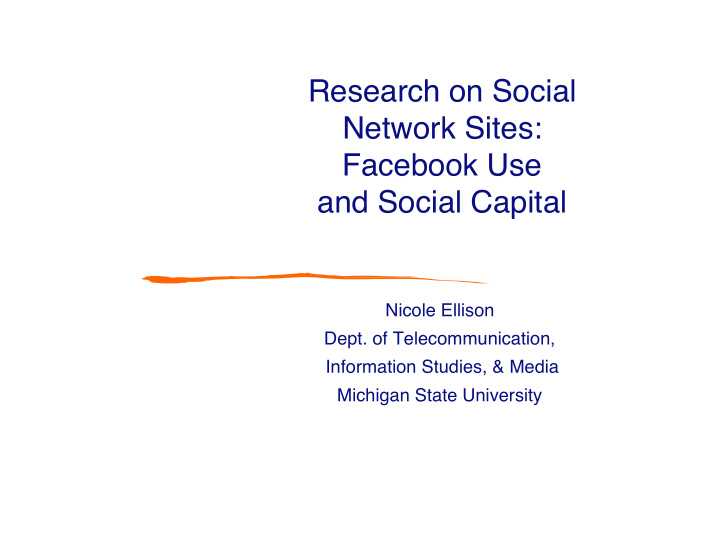



Research on Social Network Sites: Facebook Use and Social Capital Nicole Ellison Dept. of Telecommunication, Information Studies, & Media Michigan State University
Web 2.0 Key defining characteristics: WWW as platform User behavior & contributions are leveraged Data generated by these services present unique opportunities and challenges for social scientists
SNS Research: Opportunities Server-level data: Repositories of vast amounts of detailed behavioral data about individuals and their networks Allow researchers to study change over time Wide range of data (preferences, images, etc.) Experimental interventions In lab On site (e.g., via Facebook applications) Survey, interview data
SNS Research: Challenges Access to server-level data Lack of complete data (e.g., privacy settings, offline activities) Noise in data Rapidly changing technical capabilities & social norms Privacy expectations of users
Facebook Research at MSU Surveys August, 2005: series of items in survey completed by first- year students at MSU (N= 1440) April, 2006: random sample of 286 MSU undergraduates April, 2007: participants from 2006 survey (N=94) plus new random sample (N=482) April, 2008: participants from 2006 (N=93), 2007 (N=209); and new random sample (N=471) Interviews and cognitive walk-throughs Spring, 2007: Focus on FB “Friendship” (N=18) Automated capture of web content Spring, 2006: Periodic downloads of the MSU Facebook site (N=30,773)
Social Capital the resources accumulated through relationships among people; the benefits we receive from our social relationships
Bridging Social Capital is linked to “weak ties” (Granovetter, 1982), loose connections who may provide useful information or new perspectives for one another, but typically not emotional support “… technologies that expand one ʼ s social network will primarily result in an increase in available information and opportunities — the benefits of a large, heterogeneous network” (Donath & boyd, 2004).
Measures: Social Capital Bridging Social Capital: Series of 9 questions like: “Interacting with people at MSU makes me want to try new things” Bonding Social Capital: Series of 5 questions like: “If I needed an emergency loan of $100, I know someone at MSU I can turn to” Maintained Social Capital: Series of 5 questions like: “If I needed to, I could ask a high school acquaintance to do a small favor for me”
Measures: Facebook Intensity About how many total Facebook friends do you have at MSU or elsewhere? In the past week, on average, approximately how many minutes per day have you spent on Facebook? Series of 5-point Likert items: Facebook is part of my everyday activity. I am proud to tell people I'm on Facebook. Facebook has become part of my daily routine. I feel out of touch when I haven't logged onto Facebook for a while. I feel I am part of the Facebook community. I would be sorry if Facebook shut down.
Findings: Facebook use & Bridging Social Capital The more intensively respondents used Facebook, the higher their bridging social capital scores. “After first controlling for demographic factors, psychological well-being measures, and general Internet use, the extent to which students used Facebook intensively still contributed significantly (p<.0001) to bridging social capital (Adj. R 2 =.46)”
Social Capital & Facebook Use: Which came first? (Either direction is equally plausible)
Cross-lagged Correlation : Association between Facebook use in ʻ 06 and social capital in ʻ 07 is significantly stronger than the association between social capital in ʻ 06 and Facebook use in ʻ 07
Mechanism: Bridging Social Capital & Facebook Use Facebook’s social and technical affordances helps individuals accrue social capital by facilitating: the creation of a larger social network (thus more weak ties) the maintenance of this larger network social interaction within the network
Facebook makes persistent what would otherwise be ephemeral linkages (“Facebook me!”)
Network Maintenance: Facebook enables communication among weak ties
FB facilitates social interaction through the display of identity information
Facebook facilities social interaction by making commonalities visible
Are all fields created equally?
“Profile Elements as Signals in an Online Social Network” (Lampe et al.) When predicting size of network, amount of information in profile less important than whether the field is filled out or not Referents index (high school, home town) most important predictor of number of friends, followed by contacts and then interests . Referents provide common ground for interactants & reduce the transaction costs involved in locating others. ʻ Interests ʼ may be perceived as less trustworthy than verifiable fields such as high school
Ellison, N. Steinfield, C. & Lampe, C. (2007). The benefits of Facebook 'friends': Exploring the relationship between college students' use of online social networks and social capital. (In Journal of Computer-Mediated Communication http://jcmc.indiana.edu) Lampe, C., Ellison, N. and Steinfield, C. (2007). A Familiar Face(book): Profile Elements as Signals in an Online Social Network. (In CHI Proceedings) Lampe, C., Ellison, N. and Steinfield, C., (2006). A Face(book) in the Crowd: Social Searching vs. Social Browsing. (In CSCW Proceedings) Steinfield et al., (in press). Online Social Network Use, Self Esteem, and Social Capital: A Longitudinal Analysis., J. of Applied Developmental Psychology Longitudinal data to be presented at CSCW, 2009
Thank you! nellison@msu.edu
Recommend
More recommend